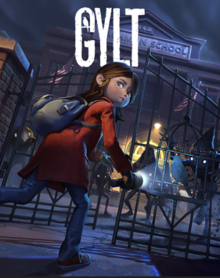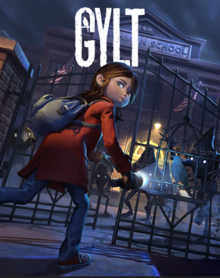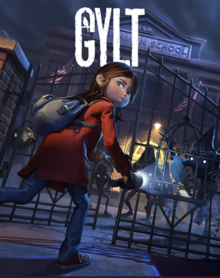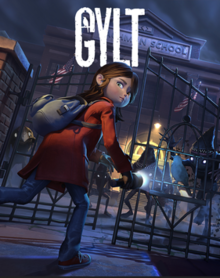
GYLT (XS) - Review
by Lee Mehr , posted on 05 August 2023 / 4,207 ViewsIn a way, GYLT's subdued opening marries its behind-the-scenes predicament: as the protagonist, Sally, continuously puts up Missing Person posters across town, so too would a select few constantly signal about the last Google Stadia exclusive holdout. Strained comparisons aside, what inspired Tequila Works' horror-adventure is a more serious matter. Spurred by a studio member's proximity to a bully situation with a younger cousin, the team drew upon that to make a "delicate horror game." While such earnest inspiration is consistently coursing through its veins, the game proper doesn't fully utilize that potent catalyst in storytelling nor design.
Similar to the real-life inspiration, the posters Sally's putting up relate to her missing cousin, Emily. Long after the local paper she stopped reporting on it, she continues littering every wall of Bethelwood, Maine with flyers. Even this desperate time in her life doesn't matter to the bullies chasing and teasing her in the dead of night. One subsequent bike crash later, she escapes them and eventually happens upon the town's cable car. After meeting a mysterious toll man and acquiring a ticket, she takes the tram, descends through a semi-transparent portal, and unknowingly enters Young Adult Silent Hill.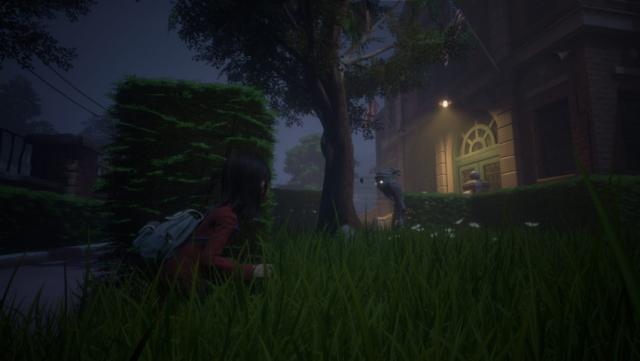
Even if there's a stronger 1:1 comparison (there's no dense fog here), the point is still the same: this old mining town looks aesthetically similar, but everything has become corrupted. The town is now dead, various cars have been randomly abandoned, and the only intact street leads suspiciously to Sally and Emily's own Bachman School. Fortunately, that's also where Emily is hiding, after catching a glimpse of her from outside. The task seems like a simple case of breaking into school, saving her, and then leaving. Seems easy enough until the first vile monster, with its eyes and mouth swapping spots, saunters into view. You can practically smell the halitosis and oily skin from the other side of the room.
This incipient stage informs GYLT's main foundation: a third-person stealth-adventure around a school and nearby locations infested with nightmarish ghouls. Being a pre-teen girl has its advantages when blocking enemies' line of sight with three-foot tall hedges and crouch-walking through A/C vents. As you become familiar with the basic rules and take in some of the T-rated horrors, Sally happens upon a flashlight that's a useful stealth, puzzle, and fighting tool. The combat didn't affect me since I went the no-kill route (except bosses) for both an achievement and the sake of the experience; after completing the campaign, action is mostly centered around using your tools to hide again anyways.
Sadly, taking a focused stealth approach interrogates some of GYLT's weakest qualities. There's a decent white/yellow/red detection color scheme displaying warning, suspicious, and caught respectively; further, I like how her last-known location (once suspicious) is marked with a silhouette. The issue is there's no clear signal as to when you might be in their line of sight. Since there's no light/shadow gradient, judging their invisible vision cone can occasionally be a crapshoot. There are also some odd double standards for sound detection: walking upright will perk their ears up, while they're copacetic about a soda can banging down a vending machine, even when standing within spitting distance. That same soda will get their attention once thrown by you though. The underlying systems for eluding enemies isn't crystal-clear, but easy to manage since enemy patrols consist of standing in place or walking back and forth.
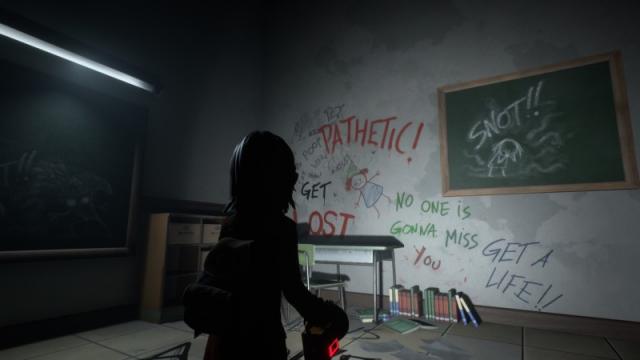
Though not directly connected to stealth, movement is also degraded because of de-emphasized platforming. Translation: your feet aren't leaving the floor. There’s no ability to jump nor clamber onto another platform; the only times Sally isn't touching the ground are when she’s dropping from a higher elevation or climbing a ladder. Beyond that meaning stealth and action exist on a flat plane, it also implicitly communicates to players their expectations with other platforms. Without any vertical experimentation, it's readily apparent where the crate-stacked cart – with yellow-painted handrails – has to go next. It’s also a tad insulting when Tequila uses a waist-high stack of boxes as a convenient roadblock; it’s unclimbable on one side while acting as a shortcut on the other.
These mechanical shortfalls are at least eased by presentational positives. The one area where T-Rated Silent Hill is just as effective is the crunchy and atmospheric sound design. Each creature has a fitting & distinctive sound, while Cris Velasco's gloomy soundtrack adds texture to what are otherwise typical environments. As formulaic as the bird enemies get, the whooshing audio feedback they make when turning around sounds perfect for them. The consistent praise for audio – sadly – wavers a bit for GYLT's art style. Though exterior and interior locales are fine, and the environmental storytelling occasionally effective, not all generic minions and bosses stimulate the imagination equally. It's also a boring creative decision for the final act to end in the most visually unstimulating place imaginable, especially when that location is thematically disconnected from the game's core focus: school bullying.
When brushing away the palpable atmosphere, GYLT's fossil feels too mechanically similar within its phylum. It's a Baby's First Adventure married with a Baby's First Stealth that's fused with a Baby's First Puzzle-Platformer – with a select few intermediate mechanics. While the golden path can become incredibly routine, secondary collectibles involving bird cages and freeing people who've frozen into stone do bump up the exploratory challenge. It captures a nice middle-ground of encouraging back-tracking without being overly demanding. And despite being insufferably easy at first, the few light and electrical grid puzzles do have a modest difficulty curve. The overarching problem is after seeing all of the basic minions and playing with the two discovered multi-purpose items, the horror and obstacles steadily lose their bite.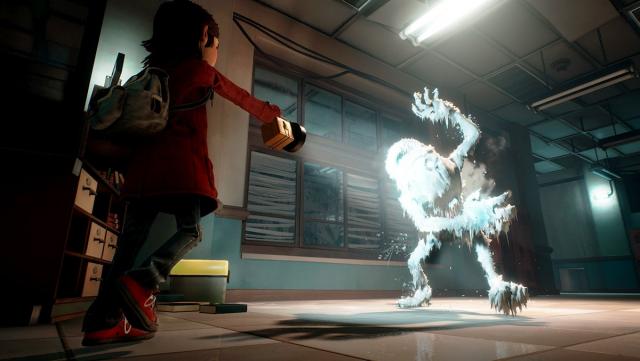
Compare that to a story that practically has no bite. To be clear, there's no denying the central theme of bullying can be a touchy topic; however, the way it's conveyed here never really lets you grab onto anything besides an aspect of it. To put it another way: name names! While rummaging through the school, finding notebooks, and seeing the depictions of bullying through mannequins, it's tough to feel traumatized when the record keeps repeating. It's all about highlighting the action as just... a bad thing keeps happening to Emily so now feel emotions. Instead of overcoming allegorical bosses named Violence or Exposure, what if there were actual personalities behind each one? Not only would that bully's putrid personality have a proper face to punch, it would also provide a more substantive backstory. This type of barebones sentimentalism invades every collectible notebook, where Emily and side characters' journals just recite the most basic of things: "I feel really depressed, anxious, or whatever else." It’s too interested in bluntly telling instead of showing.
Most of the script betrays its potential and sincerity too. Even though numerous cogs fail to emotionally click with me, the moral message addressing how anyone – whether extended family or otherwise – should succor the downtrodden is a tangible one; not participating shouldn’t be the gold standard. For most readers, revealing this part of Sally and Emily's dynamic could make you anticipate where the story goes. Whether or not you correctly predict every beat, the quality voice acting can keep anyone's attention. Dora Dolphin’s Sally is exceptional in capturing pre-teen anxiety, but Madelyn Grace absolutely sells it as Emily, particularly her blood-curdling cries during some emotional beats. There are some incredibly strong elements, but not enough meat to let players sink into this world.
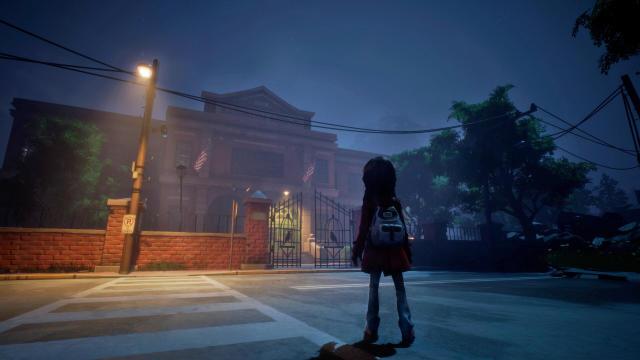
Similar in kind to Mundaun, GYLT's campaign is likely to last about 5 hours, with an extra hour or more if going for a potential completionist run. It's a fine standard to expect from a $20 title (retail), but then it can be much more strained through the lens of weighing quality and quantity.
In spite of placing itself within a more limited "delicate horror" sub-genre, GYLT too often feels like an also-ran adventure. Most broad strokes in this tale can be predicted hours in advance, not much flavoring is added to the design after a certain point, and the usual enemies begin to feel more like cosplaying nuisances than unnerving monstrosities over time. It's a case of needing one more of… everything; another secondary building or floor, another boss, another multi-purpose tool for different gameplay opportunities, and so on. These shortcomings don’t so much trample its commendable successes – especially in presentation, sincerity, and some quality design changeups – but rather illustrate how easy it is to intuit Tequila Works crafting a grander experience. As a result, it feels more like a title to be universally appreciated for its earnest aims than fondly treasured for its execution.
Contractor by trade and writer by hobby, Lee's obnoxious criticisms have found a way to be featured across several gaming sites: N4G, VGChartz, Gaming Nexus, DarkStation, and TechRaptor! He started gaming in the mid-90s and has had the privilege in playing many games across a plethora of platforms. Reader warning: each click given to his articles only helps to inflate his Texas-sized ego. Proceed with caution.
VGChartz Verdict
6
Decent
This review is based on a digital copy of GYLT for the XS
More Articles
Back when the 3DO came out they had the exclusive game Gex and I remember being jealous of it and wanting to play it but knew I was never going to buy a 3DO. It eventually came to all systems...and I never bought it/ or played it. This kind of feels similar, in that it was on a system I was never going to buy and it looked interesting. Now that it has been released on other consoles, I'm kind of meh on it all of a sudden. Maybe I'll pick it up on sale or play it if it comes to gamepass or playstation +
You know... Gex is a perfect example of a "FOMO game" for me too. My timeline doesn't go back to knowing about 3DO at the time, but rather when it made it's way to other systems except N64. But then you see it in action elsewhere and aren't as enamored by your original hype after a landmark like Super Mario 64, except for the cool factor. GYLT maps onto that if you replace coolness for sincerity.
I'm terrible at resisting FOMO that way. I bought a 3DO back in the day for Crash n' Burn and wound up being pretty disappointed all in all. Though I did manage to find a small library of enjoyable titles for it...eventually. (Total Eclipse, Captain Quasar, and most of all D, in addition to Gex.) Likewise, I have the shame of...struggling to admit this in public, one sec...having actually bought a Stadia for Gylt, to similar results. It wound up being, you know, okay. Gylt, I mean, not the platform more largely. In my defense, the Stadia was on sale for $40 at the time. When I see trailers that look comparable to Gylt's today, there's no way I'd make a purchase as a result, by contrast. Time does indeed have a way of shifting one's sensibilities.
























